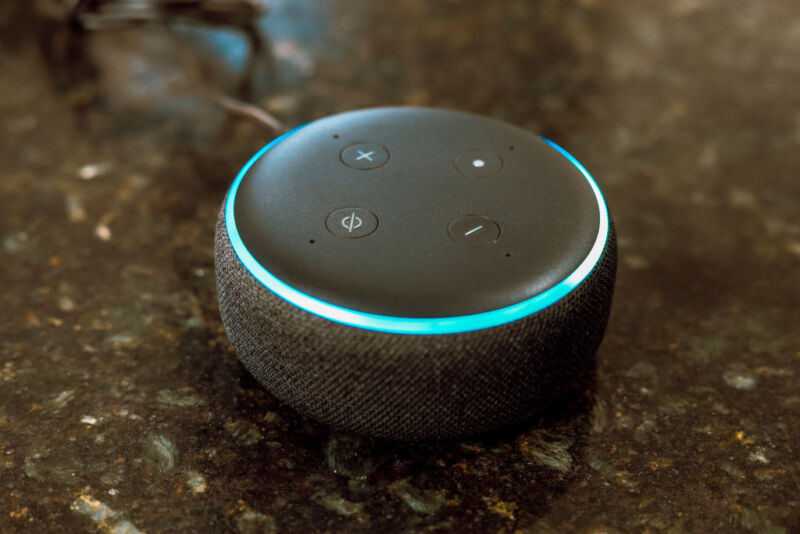WSJ report highlights vague metrics, internal struggles of Amazon Devices.

The Amazon business unit that focuses on Alexa-powered gadgets lost $25 billion between 2017 and 2021, The Wall Street Journal (WSJ) reported this week.
Amazon claims it has sold more than 500,000,000 Alexa devices, which included Echo speakers, Kindle readers, Fire TV sets and streaming devices, and Blink and Ring smart home security cameras. But since debuting, Alexa, like other voice assistants, has struggled to make money. In late 2022, Business Insider reported that Alexa was set to lose $10 billion that year.
“No profit timeline”
WSJ’s report claims to offer insight into how Devices was able to bleed so much money for so long.
For one, it seems like the business unit was allowed some wiggle room in terms of financial success in the interest of innovation and the potential for long-term gains. Someone the WSJ described as being “a former longtime Devices executive” said that when Alexa first started, Amazon’s gadgets team “didn’t have a profit timeline” when launching products.
Amazon is known to have sold Echo speakers for cheap or at a loss in the hopes of making money off Alexa later. In 2019, then-Amazon Devices SVP Dave Limp, who exited the company last year, told WSJ: “We don’t have to make money when we sell you the device.” WSJ noted that this strategy has applied to other unspecified Amazon devices, too.
ARS VIDEO
How The Callisto Protocol’s Gameplay Was Perfected Months Before Release
People tend to use Alexa for free services, though, like checking the weather or the time, not making big purchases.
“We worried we’ve hired 10,000 people and we’ve built a smart timer,” a former senior employee told the WSJ.
An Amazon spokesperson told the WSJ that more than half of people with an Echo have shopped with it but wouldn’t provide more specifics. Per “former employees on the Alexa shopping team” that WSJ spoke with, however, the amount of shopping revenue tied to Alexa is insignificant.
In an emailed statement, an Amazon spokesperson told Ars Technica, in part:
Within Devices & Services, we’re focused on the value we create when customers use our services, not just when they buy our devices. Our Devices & Services organization has established numerous profitable businesses for Amazon and is well-positioned to continue doing so going forward.
Further hindering Alexa’s revenue are challenges in selling security and other services and the limitation of ad sales because they annoy Alexa users, WSJ reported.
Massive losses also didn’t seem to slow down product development. WSJ claimed the Devices business lost over $5 billion in 2018 yet still spent money developing the Astro consumer robot. That robot has yet to see general availability, while a business version is getting bricked just 10 months after release. Amazon Halo health trackers, which have also been bricked, and Luna game-streaming devices were also developed in 2019, when the hardware unit lost over $6 billion, per WSJ.
Amazon has laid off at least 19,000 workers since 2022, with the Devices division reportedly hit especially hard.
A vague metric of success
WSJ’s report also suggests that Alexa, like other Amazon offerings, were judged by an imprecise metric called “downstream impact.” Reportedly developed in 2011 by economists, downstream impact “assigns a financial value to a product or a service based on how customers spend within Amazon’s ecosystem after they buy it,” WSJ said.
This metric has been reasonable for devices that, for example, had valued subscription services or were tied to ad sales (like Fire TV devices). But other devices, like the Echo, might have been leveraging the metric in a way that made them seem more lucrative than they actually were.
For example, Devices team members would show senior management the top estimate for downstream impact and use downstream impact figures to justify high expenses, like large headcounts. This metric also resulted in revenue sometimes being counted twice, per “former executives” who spoke with WSJ.
WSJ claimed that under Amazon CEO Andy Jassy, downstream impact became less valued, and products with reported limited hope for profitability, like Amazon Glow and Halo, were terminated.
Amazon’s spokesperson told Ars that the company will continue using metrics besides hardware margins to measure the success of its Devices and Services unit and working in emerging business areas as an investment.
Hail Mary attempt
Amazon is now banking on the impending release of a subscription-based gen AI Alexa to finally drive profits. The idea is that people will be willing to pay a recurring fee to use Alexa if it can do more advanced things, like perform multiple commands without the user having to say “Alexa” repeatedly, be more conversational, and manage smart homes more intuitively. Amazon is considering charging $5 to $10 per month for generative AI Alexa, Reuters reported in June. Per WSJ’s report, pricing hasn’t been finalized.
WSJ noted one person working on the chatbot who doubts whether people are willing to pay for yet another subscription. Indeed, subscription fatigue is a real business concern. A 2023 survey from Civic Science found that 50 percent of people experienced subscription fatigue, and 57 percent of respondents in a 2024 survey from The Motley Fool think they spend too much on subscriptions. With more companies ditching one-time fees for subscriptions and the price of various subscriptions—from video streaming to music services like Spotify—generally on the rise, people’s tolerance for monthly payments is fragile. Generative AI Alexa isn’t expected to be included in any of Amazon’s already available subscriptions, like Prime, Prime Video, or Amazon Music.
Generative AI Alexa is expected to debut sometime this year, but it may not be ready yet. Per the anonymous person working on the project:
The technology isn’t there, but they have a deadline [to launch the product].
This isn’t the first time we’ve heard of internal strife regarding the subscription service. In January, Business Insider reported that internal politics and bloated tech were making it hard to revamp Alexa. The report also highlighted the dire need for this version of Alexa to make money to keep the voice assistant alive.
Amazon’s spokesperson claimed to WSJ and Ars that the new Alexa’s potential goes further than what appears on balance sheets. But there are various additional reasons to question generative AI as Alexa’s savior.
In the past decade, voice assistants have failed to prove their value beyond aiding menial tasks like alarm setting. Amazon is betting big on its ability to shake a 10-year-old reputation and do something that no other voice assistant has done and do it successfully.
Amazon also has to deal with swathes of privacy concerns tied to voice assistants in general, integrated cameras, and its own reputation, which includes instances of the company keeping Alexa recordings forever, listening to audio derived from Alexa, and spying on its smart camera users.
It’s also unclear how long Amazon will be able to support the new Alexa. With the Devices unit losing billions, it may not have much time to build enough success to keep the product afloat. Further, Amazon has lost some customer trust by quickly bricking devices, like Halo and the Astro business robot.
Amazon’s spokesperson claimed that the company is confident that it’s building the best personal assistant. But generative AI is a desperate shot. It’s dependent on Amazon’s abilities to compete with already established chatbots and change people’s perspective of Alexa and voice assistants in general, as well as Amazon. It’s a tall order, and a rushed product with questionable internal confidence is unlikely to get the job done.




